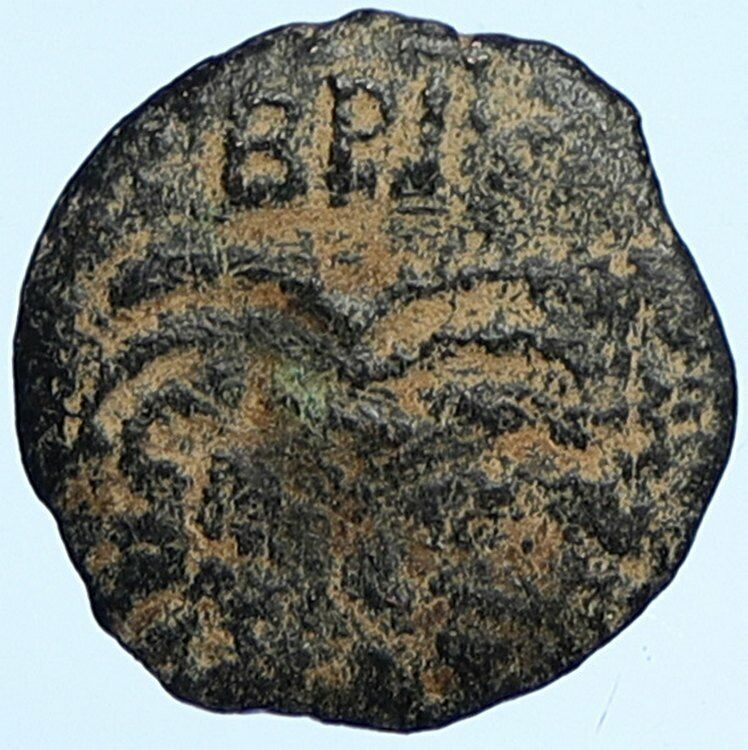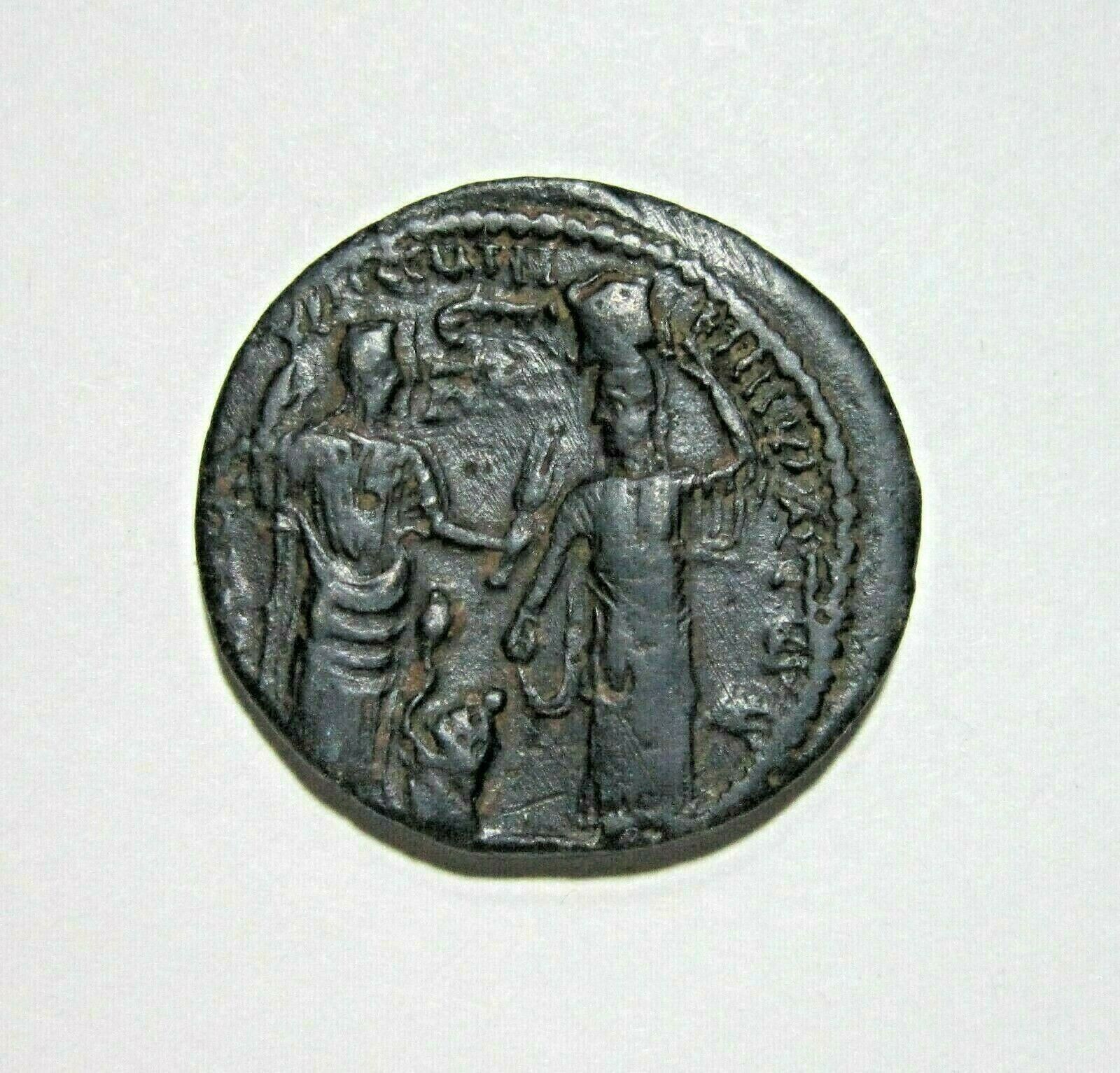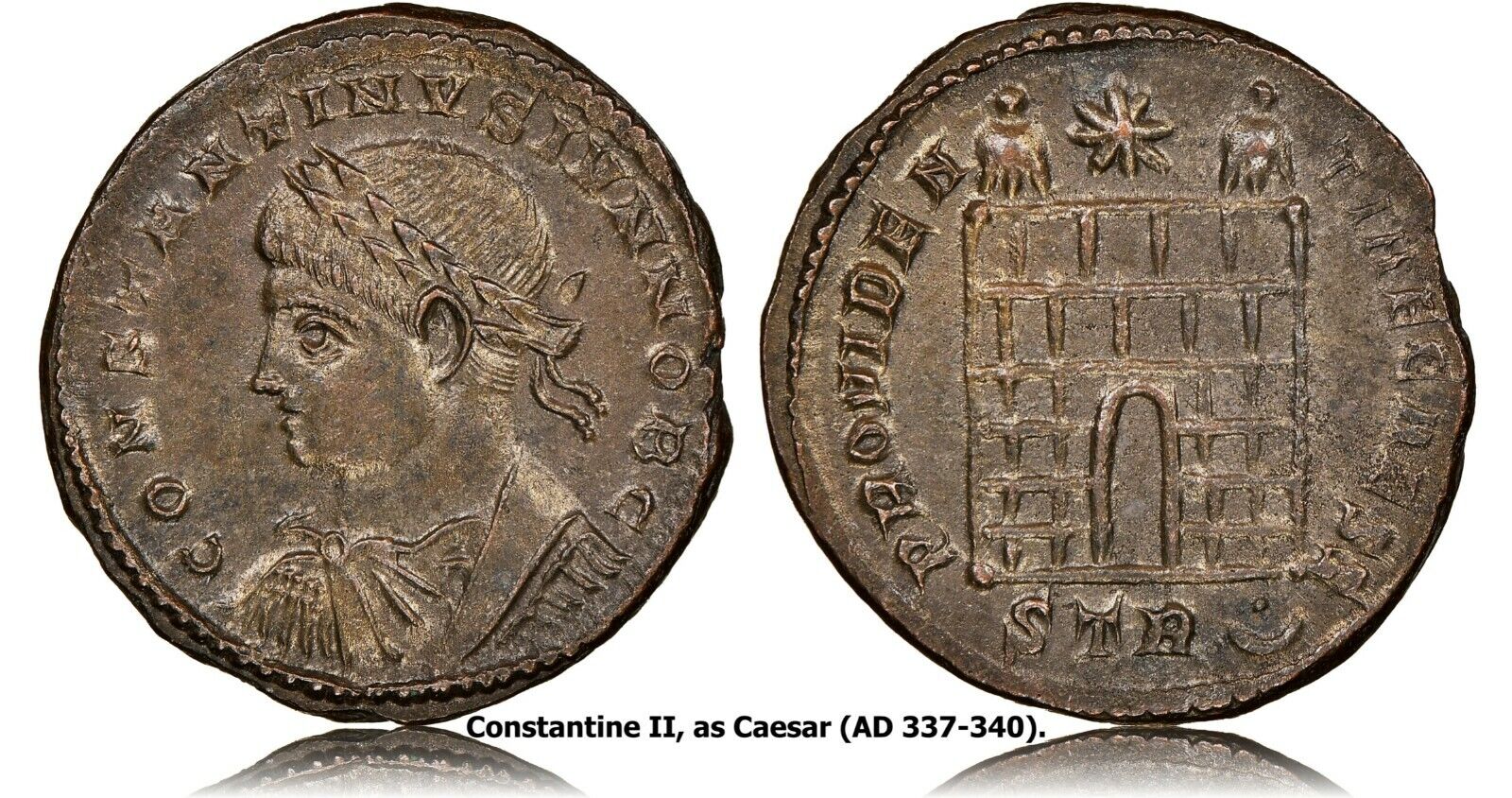-40%
GORDIAN III Authentic Ancient 238AD Roman Coin of Tomis w NIKE - NEMESIS i79935
$ 73.28
- Description
- Size Guide
Description
Item:i79935
Authentic Ancient Coin of:
Gordian III
-
Roman Emperor
: 238-244 A.D.
Bronze Tetrassarion 24mm (9.77 grams) of
Tomis
in Moesia Inferior
Laureate draped and cuirassed bust of Gordian III right.
MHTPOΠΟNTOV TOMEΩC, Nike-Nemesis standing left with wheel at feet.
Very interesting symbolism of Nemesis with the wheel and the clear and evident wings of Nike, making it Nike-Nemesis, a combination of the two goddesses.
You are bidding on the exact item pictured, provided with a Certificate of Authenticity and Lifetime Guarantee of Authenticity.
Tomis
(also called Tomi) was a Greek colony in the province of Scythia Minor on the Black Sea's shore, founded around 600 BC for commercial exchanges with the local Getic populations. Probably the name is derived from Greek
Τομή
meaning cut, section.
According to one myth dating from Antiquity, found in the Bibliotheca, it was founded by Aeetes:
"When Aeetes discovered the daring deeds done by Medea, he started off in pursuit of the ship; but when she saw him near, Medea murdered her brother and cutting him limb from limb threw the pieces into the deep. Gathering the child's limbs, Aeetes fell behind in the pursuit; wherefore he turned back, and, having buried the rescued limbs of his child, he called the place
Tomi
."
Another legend is recorded by Jordanes (after Cassiodorus), who ascribes the foundation of the city to a Getae queen (The origin and deeds of the Goths):
"After achieving this victory (against Cyrus the Great) and winning so much booty from her enemies, Queen Tomyris crossed over into that part of Moesia which is now called Lesser Scythia - a name borrowed from Great Scythia -, and built on the Moesian shore of the Black Sea the city of Tomi, named after herself."
In 29 BC the Romans captured the region from the Odryses, and annexed it as far as the Danube, under the name of
Limes Scythicus
.
In AD 8, the Roman poet Ovid (43 BC-17) was banished here by Augustus and died there eight years later. He laments his exile in Tomis in his poems the
Tristia
and
Epistulae Ex Ponto
. Tomis was "by his account a town located in a war-stricken cultural wasteland on the remotest margins of the empire". A statue of Ovid stands in the Ovid Square (
Piaţa Ovidiu
) of Constanţa, in front of the History Museum (the former City Hall).
A number of inscriptions found in the city and its vicinity show that Constanţa lies where Tomis once stood. The city was afterwards included in the Province of Moesia, and, from the time of Diocletian, in Scythia Minor, of which it was the metropolis. After the split of the Roman Empire, Tomis fell under the rule of the Eastern Roman Empire. During Maurice's Balkan campaigns, Tomis was besieged by the Avars in the winter of 597/598.
Tomis was later renamed to Constantiana in honour of Constantia, the half-sister of Constantine the Great (274-337). The earliest known usage of this name was "Κωνστάντια" ("Constantia") in 950. The city lay at the seaward end of the Great Wall of Trajan, and has evidently been surrounded by fortifications of its own. After successively becoming part of the Bulgarian Empires, the independent principality of Dobrotitsa/Dobrotici and of Wallachia under Mircea I of Wallachia, Constanţa fell under the Ottoman rule around 1419.
A railroad linking Constanţa to Cernavodă was opened in 1860. In spite of damage done by railway contractors there are considerable remains of ancient masonry walls, pillars, etc. An impressive public building, thought to have originally been a port building, has been excavated, and contains the substantial remains of one of the longest mosaic pavements in the world. In 1878, after the Romanian War of Independence, Constanţa and the rest of Northern Dobruja were ceded by the Ottoman Empire to Romania. The city became Romania's main seaport and transit point for much of Romania's exports.
On October 22, 1916 (during World War I), the Central Powers (German, Turkish and Bulgarian troops) occupied Constanţa. According to the Treaty of Bucharest in May 1918, article 10.b (treaty which has never been ratified by Romania), Constanţa remained under the joint control of the Central Powers. Allied troops liberated the city in 1918 after the successful offensive on the Thessaloniki front knocked Bulgaria out of the war.
In the interwar years, the city became Romania's main commercial hub, so that by the 1930s over half of the national exports were going through the port. During World War II, when Romania joined the Axis powers, Constanţa was one of the country's main targets for the Allied bombers. While the town was left relatively undamaged, the port suffered extensive damage, recovering only in the early 1950s.
Furia Sabinia Tranquillina
or
Sabinia Tranquillina
(ca 225 - aft. 244) was the Empress of Rome and wife of Emperor Gordian III. She was the young daughter of the Praetorian Prefect Timesitheus by an unknown wife.
In 241 her father was appointed the head of the Praetorian Guard by the Roman Emperor Gordian III. In May that year, Tranquillina had married Gordian. She became a Roman Empress and received the honorific title of
Augusta
. Her marriage to Gordian was an admission by the young emperor of both political indispensability of Timesitheus and Tranquillina's suitability as an empress.
In 243, Tranquillina's father suddenly died and was replaced with Philip the Arab, as head of the Praetorian Guard. When Gordian was killed in February 244, Philip became the new emperor. Tranquillina survived her husband. She had no sons with him. Christian Settipani suggests that they had a daughter, (Furia) (b. ca 244), most likely posthumous, who married (Marcus Maecius Orfitus) (b. ca 245), son of Marcus Maecius Probus (b. ca 220), married to Pupiena Sextia Paulina Cethegilla (b. ca 225), paternal grandson of Marcus Pomponius Maecius Probus and maternal grandson of Marcus Pupienus Africanus (son of his protector Emperor Pupienus Maximus) and wife Cornelia Marullina, by whom she had issue.
Gordian III
-
Roman Emperor
: 238-244 A.D.
Caesar: 238 A.D. (under
Balbinus
and
Pupienus
)
Augustus: 238-244 A.D.
| Grandson of
Gordian I
| Nephew of
Gordian II
| Adopted Successor of
Balbinus
and
Pupienus
| Husband of
Tranquillina
|
Gordian III
(Latin:
Marcus Antonius Gordianus Pius Augustus
; 20 January 225 AD - 11 February 244 AD) was Roman Emperor from 238 AD to 244 AD. At the age of 13, he became the youngest sole legal Roman emperor throughout the existence of the united Roman Empire. Gordian was the son of Antonia Gordiana and an unnamed Roman Senator who died before 238. Antonia Gordiana was the daughter of Emperor Gordian I and younger sister of Emperor Gordian II. Very little is known of his early life before his acclamation. Gordian had assumed the name of his maternal grandfather in 238 AD.
In 235, following the murder of Emperor Alexander Severus in Moguntiacum (modern Mainz), the capital of the Roman province Germania Superior, Maximinus Thrax was acclaimed Emperor. In the following years, there was a growing opposition against Maximinus in the Roman senate and amongst the majority of the population of Rome. In 238 a rebellion broke out in the Africa Province, where Gordian's grandfather and uncle, Gordian I and II, were proclaimed joint emperors. This revolt was suppressed within a month by Cappellianus, governor of Numidia and a loyal supporter of Maximinus Thrax. The elder Gordians died, but public opinion cherished their memory as peace-loving and literate men, victims of Maximinus' oppression.
Meanwhile, Maximinus was on the verge of marching on Rome and the Senate elected Pupienus and Balbinus as joint emperors. These senators were not popular men and the population of Rome was still shocked by the elder Gordian's fate, so the Senate decided to take the teenager Gordian, rename him Marcus Antonius Gordianus like his grandfather, and raise him to the rank of
Caesar
and imperial heir. Pupienus and Balbinus defeated Maximinus, mainly due to the defection of several legions, particularly the II
Parthica
, who assassinated Maximinus. However, their joint reign was doomed from the start with popular riots, military discontent and an enormous fire that consumed Rome in June 238. On July 29, Pupienus and Balbinus were killed by the Praetorian Guard and Gordian proclaimed sole emperor.
Rule
Due to Gordian's age, the imperial government was surrendered to the aristocratic families, who controlled the affairs of Rome through the Senate. In 240, Sabinianus revolted in the African province, but the situation was quickly brought under control. In 241, Gordian was married to Furia Sabinia Tranquillina, daughter of the newly appointed praetorian prefect, Timesitheus. As chief of the Praetorian Guard and father in law of the Emperor, Timesitheus quickly became the
de facto
ruler of the Roman Empire.
In the 3rd century, the Roman frontiers weakened against the Germanic tribes across the Rhine and Danube, and the Sassanid Empire across the Euphrates increased its own attacks. When the Persians under Shapur I invaded Mesopotamia, the young emperor opened the doors of the Temple of Janus for the last time in Roman history, and sent a large army to the East. The Sassanids were driven back over the Euphrates and defeated in the Battle of Resaena (243). The campaign was a success and Gordian, who had joined the army, was planning an invasion of the enemy's territory, when his father-in-law died in unclear circumstances. Without Timesitheus, the campaign, and the Emperor's security, were at risk.
Gaius Julius Priscus and, later on, his own brother Marcus Julius Philippus, also known as Philip the Arab, stepped in at this moment as the new Praetorian Prefects and the campaign proceeded. Around February 244, the Persians fought back fiercely to halt the Roman advance to Ctesiphon. Persian sources claim that a battle occurred (Battle of Misiche) near modern Fallujah (Iraq) and resulted in a major Roman defeat and the death of Gordian III. Roman sources do not mention this battle and suggest that Gordian died far away from Misiche, at Zaitha (Qalat es Salihiyah) in northern Mesopotamia. Modern scholarship does not unanimously accept this course of the events. One view holds that Gordian died at Zaitha, murdered by his frustrated army, while the role of Philip is unknown. Other scholars, such as Kettenhofen, Hartman and Winter have concluded that Gordian died in battle against the Sassanids.
Philip transferred the body of the deceased emperor to Rome and arranged for his deification. Gordian's youth and good nature, along with the deaths of his grandfather and uncle and his own tragic fate at the hands of the enemy, earned him the lasting esteem of the Romans. The soldiers held Gordian in high esteem, as he had possibly sacrificed his life to save them in 244.
Frequently Asked Questions
Mr. Ilya Zlobin
, world-renowned expert numismatist, enthusiast, author and dealer in authentic ancient Greek, ancient Roman, ancient Byzantine, world coins & more.
Who am I dealing with?
You are dealing with Ilya Zlobin, ancient coin expert, enthusiast, author and dealer with an online store having a selection of over 15,000 items with great positive feedback from verified buyers and over 10 years experience dealing with over 57,000 ancient and world coins and artifacts. Ilya Zlobin is an independent individual who has a passion for coin collecting, research and understanding the importance of the historical context and significance all coins and objects represent. Most others are only concerned with selling you, Ilya Zlobin is most interested in educating you on the subject, and providing the largest selection, most professional presentation and service for the best long-term value for collectors worldwide creating returning patrons sharing in the passion of ancient and world coin collecting for a lifetime.
How long until my order is shipped?
Orders are shipped by the next business day (after receipt of payment) most of the time.
How will I know when the order was shipped?
After your order has shipped, you will be left positive feedback, and that date could be used as a basis of estimating an arrival date. Any tracking number would be found under your 'Purchase history' tab.
USPS First Class mail takes about 3-5 business days to arrive in the U.S. International shipping times cannot be estimated as they vary from country to country.
Standard international mail to many countries
does not
include a tracking number, and can also be slow sometimes.
For a tracking number and signature confirmation, you may want to do Express Mail International Shipping, which costs more, however, is the fastest and most secure. Additionally you may be able to receive your order in as little as 3-5 business days using this method. For Express Mail International, it may be possible to place up to 10-15 items in one package (for the one shipping cost) as it is flat rate envelope, which may be the most cost-effective, secure and fastest way to receive items internationally. Send me a message about this and I can update your invoice should you want this method.
Getting your order to you, quickly and securely is a top priority and is taken seriously here.
Great care is taken in packaging and mailing every item securely and quickly.
Please be aware, I cannot take responsibility for any postal service delivery delays, especially for international packages as it may happen in rare instances.
What is a certificate of authenticity and what guarantees do you give that the item is authentic?
Each of the items sold here, is provided with a Certificate of Authenticity, and a Lifetime Guarantee of Authenticity, issued by a world-renowned numismatic and antique expert that has identified over 57,000 ancient coins and has provided them with the same guarantee. You will be very happy with what you get with the COA; a professional presentation of the coin, with all of the relevant information and a picture of the coin you saw in the listing. Additionally, the coin is inside it's own protective coin flip (holder), with a 2x2 inch description of the coin matching the individual number on the COA.
On the free-market such a presentation alone, can be considered a - value all in itself, and it comes standard with your purchases from me,
FREE.
With every purchase, you are leveraging my many years of experience to get a more complete context and understanding of the piece of history you are getting. Whether your goal is to collect or give the item as a gift, coins presented like this could be more prized and valued higher than items that were not given such care and attention to.
Buy a coin today and own a piece of history, guaranteed.
Is there a money back guarantee?
I offer a 30 day unconditional money back guarantee. I stand behind my coins and would be willing to exchange your order for either store credit towards other coins, or refund, minus shipping expenses, within 30 days from the receipt of your order. My goal is to have the returning customers for a lifetime, and I am so sure in my coins, their authenticity, numismatic value and beauty, I can offer such a guarantee.
When should I leave feedback?
Once you receive your order, please leave a positive feedback. Please don't leave any negative feedbacks, as it happens sometimes that people rush to leave feedback before letting sufficient time for their order to arrive. Also, if you sent an email, make sure to check for my reply in your messages before claiming that you didn't receive a response. The matter of fact is that any issues can be resolved, as reputation is most important to me. My goal is to provide superior products and quality of service.
How and where do I learn more about collecting ancient coins?
Visit the "
Guide on How to Use My Store
" for on an overview about using my store, with additional information and links to all other parts of my store which may include educational information on topics you are looking for.











